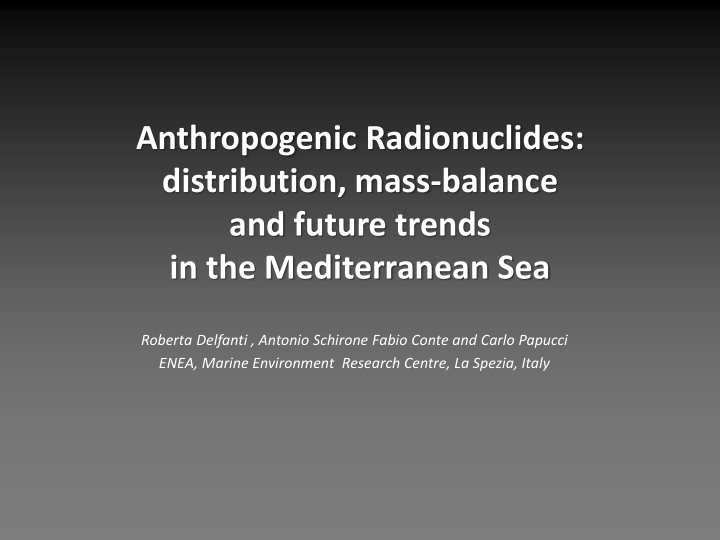



Anthropogenic Radionuclides: distribution, mass-balance and future trends in the Mediterranean Sea Roberta Delfanti , Antonio Schirone Fabio Conte and Carlo Papucci ENEA, Marine Environment Research Centre, La Spezia, Italy
Outline • The Mediterranean Sea • Sources of radioactivity • Distribution and time trend in seawater and sediment • Inventories and budgets in the basin • Exchanges at the Straits • Future trends • Examples on the use of 137 Cs as tracer
The Mediterranean Sea Turkish Straits Tyrrhenian Gibraltar Ionian Sicily Channel Levantine Deep Sea, shelf < 10% of surface area, concentration basin, E > R+P
Anthropogenic radionuclides delivered to the Mediterranean Sea from different sources (reference time: 2010) 137 Cs 239,240 Pu Source (PBq) (TBq) 4.1 200 Global fallout, up to 2000 1.4 0.02 Chernobyl fallout 0.03 1.2 Global fallout, 2000 - 2010 0.03 0.37 Marcoule reprocessing plant 0.06 3 Black Sea, up to 1986 0.3 0.4 Black Sea, 1986-2010 Exchanges with Atlantic Ocean, 0.9 - 40 up to 1986 Exchanges with Atlantic Ocean, = -6.8 1990-2010 0.005 - Input from rivers Total 6.8 158.2
Time trend of 137 Cs concentration in surface seawater
Time trend of 137 Cs concentration in the water column Cs-137 (mBq L-1), dec. corr. 2010 0 1 2 3 4 5 Cs-137 (mBq L-1), dec. corr. 2010 0 0 1 2 3 4 5 0 500 1000 500 1500 ENEA 2008 1000 Depth (m) 2000 WHOI 1975 ENEA 2005 Depth (m) 2500 1500 DHI 1970 3000 2000 3500 2500 4000 3000
137 Cs section in the S-Mediterranean water column, 2005 - 2008 Cs-137 Gibraltar Sicily Strait Rhodes Whole Med Inventory: 6.1 PBq
Inventories of 137 Cs (kBq m -2 ) in sediments, 2010 Prodelta mud: 1 - 30 Shelf mud: 0.5 - 3 Rhone Prodelta Sand: 0.2 - 0.6 1 - 200 Spanish Margin 0.1 – 0.5 0.06 – 0.15 0.09 0.14 – 0.25 0.08 – 0.12 0.08 – 0.11 Data from: Delfanti et al., 1997. Charmasson, 2003. Gascò et al., 2002. Noureddine et al., 2008 Garcia-Orellana et al., 2009. Barsanti et al., submitted.
Time trend of 239,240 Pu concentration in the water column WMED IAEA IAEA-MEL Inventory: 50 Bq m-2
Inventory of 137 Cs and 239,240 Pu in the Mediterranean Sea, 2010 Compartment 137Cs % 239,240Pu % PBq delivery TBq delivery Water column 6.1 90 75 47 0-4000 m Shelf 0.2 3 40 25 Sediment Deep sea 0.2 3 7 4 sediment Total 6.5 96 122 76
Fluxes of 137 Cs and 239,240 Pu at the Straits (TBq y -1 ) 72 ± 18 0.28 ± 0.11 61 ± 13 0.62 ± 0.16 Gasco et al., 2002
Conclusions (1) In the Mediterranean Sea: • Most anthropogenic radionuclides are still in the water column. • For 239,240 Pu important reservoirs are shelf sediments. • Rad levels in biota low – no concern • Inventories will decrease in future: – No significant sources – Pu export at Gibraltar – Cs decrease by decay not balanced by input from Black Sea
137 Cs in the water column of the Mediterranean Sea, 2005 - 2008 Cs-137 Gibraltar Sicily Strait Rhodes Small concentration range: 1.2 – 3.2 Bq m -3 Still significant differences in different water masses
The evolution of the Eastern Mediterranean Transient through tracer data Tritium Section, 1987 Until 1987 Roether et al., 1999
The evolution of the Eastern Mediterranean Transient through tracer data X In the 1990s Sicily Crete
The evolution of the Eastern Mediterranean Transient through tracer data In the 2000s
Time trend of 137 Cs concentration in the water column Ionian Sea, 1975 - 2008 Cs-137 (mBq/L) W-Ionian, dec. corr. 2010 Cs-137 (mBq/L) W-Ionian, dec. corr. 2010 Cs-137 (mBq/L) W-Ionian, dec. corr. 2010 0 0 0 1 1 1 2 2 2 3 3 3 4 4 4 0 0 0 1000 1000 1000 Press. (dbar) Press. (dbar) Press. (dbar) 1997 2000 2000 2000 1999 2002 3000 3000 3000 4000 4000 4000 2008
Time trend of 137 Cs concentration in the water column Tyrrhenian Sea, 1975 - 2008 Cs-137 (Bq m-3) 0 1 2 3 4 5 137 Cs in LIW and in tEMDW at the western sill of the Sicily Channel 0 Conc. of 137 Cs conc. in LIW and tEMDW 1993 - 2007 5 at the W -Sicily Strait , 1993-2005 500 1000 4 2004 2001 1500 1996 -3 ) 137 Cs (Bq m 1993 Depth (m) 3 2000 2500 2 3000 1 3500 1992 1994 1996 1998 2000 2002 2004 2006 2008 2010 Year 4000
Conclusion (2) • 137 Cs distribution can still complement other studies and give indipendent evidence of changes in the thermohaline circulation of the Mediterranean Sea. • Key-stations identified in the different basins: here time series measurements will be continued, to elucidate mechanisms of water mass transport and transformation.
Recommend
More recommend